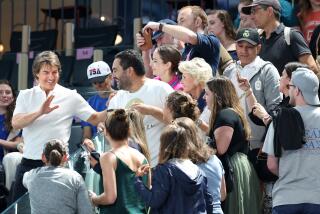This Event Is Definitely Missing Its Usual Staples
- Share via
Men In Black On Ice was the theme on a monochrome kind of night at the U.S. Figure Skating Championships on Tuesday, but first, let’s start with what was missing at Staples Center.
Staples.
The question came quickly to mind, right after where have all the figure skating fans gone, where have all the giraffe costumes gone and where, more specifically, have all of Michael Weiss’ jumps gone?
Where have all the flowers gone?
It used to be an undeniable fundamental of the sport, its unique branding device. After a skater completes his or her routine, tradition holds that appreciative fans show their approval by pelting the ice with floral bouquets. It’s always done at proper figure skating competitions, along with occasional tossing of stuffed toys. And, on rare occasions, such as the 1998 Olympic trials in Philadelphia, where fans still were a little unfamiliar with the basics, stuffed toys still unwrapped inside their cardboard boxes were flung onto the ice, sending skaters running for cover.
In sports, you are what you throw. In hockey, fans in Detroit litter the ice with slimy eight-legged sea creatures, Detroit being a big sushi town. In football, fans in Cleveland litter the field with plastic beer bottles, Cleveland being a big plastic beer bottle town. In baseball, fans in New York take home-run balls hit by the opposition and heave them back onto the field as part act of defiance, part hey-welcome-to-the-neighborhood.
And in figure skating, they throw flowers.
But not at Staples, not in security-tight 2002, with metal detectors still framing the entrance doors and security guards shaking down writers brazen enough to carry diet soda cans from the media lounge to the media workroom.
In preparation of the fortress conditions expected next month at Salt Lake City, the Olympic figure skating trials in Los Angeles are a little nervous, which is understandable, even though bouquets, at first glance, would not seem a significant threat.
Except for the staples that hold the cellophane wrapping around the flower. Those staples have been deemed dangerous to the arena’s ice surface, which is chewed up by King defensemen on a regular basis but must, according to the rules, be kept in pristine condition for the figure skaters.
So, these U.S. championships have been de-flowered.
They also have been de-populated, judging by the early returns. For the opening night of elite competition, the men’s short program, the arena was less than half-full. This could be attributed to an inexplicably late 8 p.m. start--with no live TV, there was really no reason to start so late and blow newspaper deadlines from the Rockies to New England, except that another figure skating tradition holds that all of these sort of events require an opening ceremony.
So before Timothy Goebel, Weiss and Co. could skate before the empty seats, the few fans rattling around the building were treated to a half-hour retrospective on the 1972 Olympic trials, which featured old footage of young men and women skating before the empty seats at Long Beach Arena.
(Interesting, though: The suite level appeared filled to capacity. SRO in the private boxes. Not surprising, considering the sport’s target demographic. From sequins to baubles to the platinum credit cards in the audience, it’s quite the suite science.)
Also missing, sadly, is the kind of sartorial insanity that used to make men’s skating worth the price of admission. The reigning men’s Olympic champion, Ilia Kulik, is remembered not so much for his acrobatic virtuosity at Nagano as for his stirring impersonation of a jellyfish during his short program, followed by the now-legendary giraffe-spotted rain slick he donned for his long program.
Tuesday, there was none of that. Instead, with few exceptions, it was black on black on black.
Todd Eldredge, five-time U.S. champion, glided out in all black, save for a trio of crimson stripes across his left sleeve and down his right torso. Weiss, the 1999 and 2000 U.S. titlist? All black, with a top splattered in sequins.
It set the tone for a drab, unadventurous evening--at least until Weiss launched into his first element, a quadruple-toe/triple-toe combination, which he failed to land. The quad wasn’t necessary. As strategies go, it was a triumph of flash over substance. But Weiss had been hitting it in practice, so he brought it out in competition, doing what he could to enliven the somber proceedings.
Worse still, he botched his second element as well, a triple axel. A big 0 for 2, right out the gate, leaving Weiss fifth, behind Eldredge and Goebel, tied for first, and third-place Matt Savoie, who dared to wear burgundy, and fourth-place Johnny Weir.
Eldredge had a bit of trouble with a triple lutz, and later complained about the quality of the ice. A little choppy here, a little patchy there.
And that was without the staples.
More to Read
Go beyond the scoreboard
Get the latest on L.A.'s teams in the daily Sports Report newsletter.
You may occasionally receive promotional content from the Los Angeles Times.






